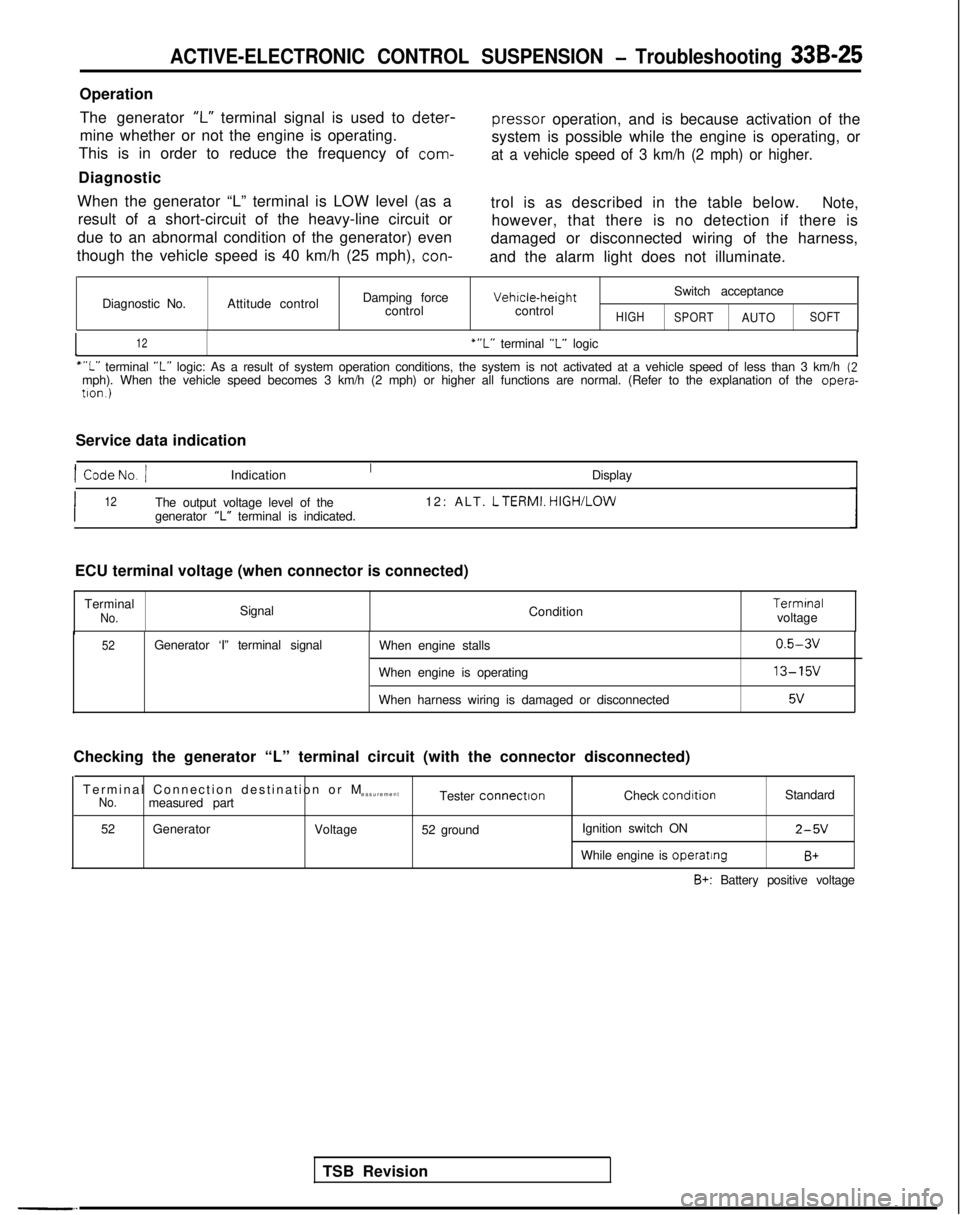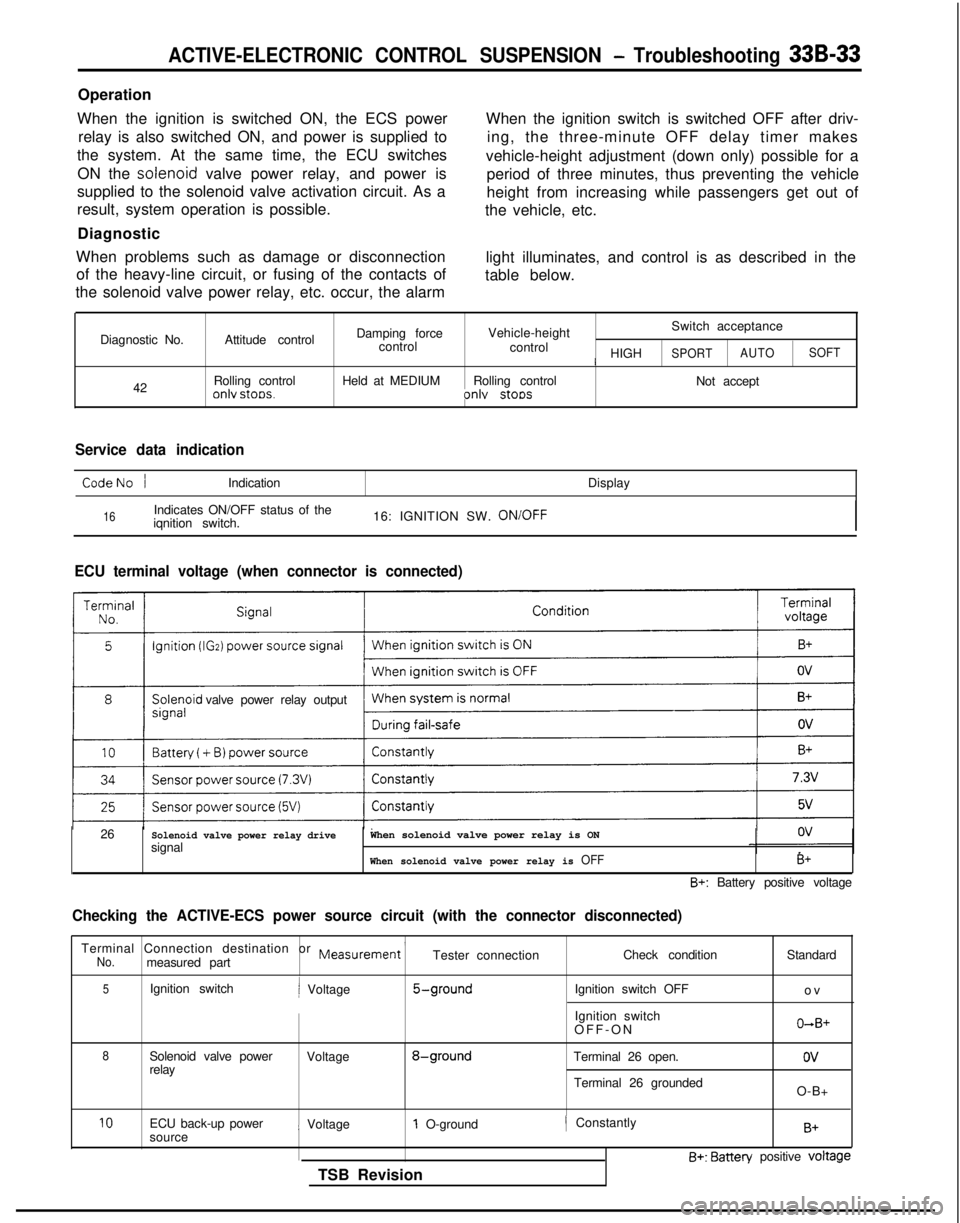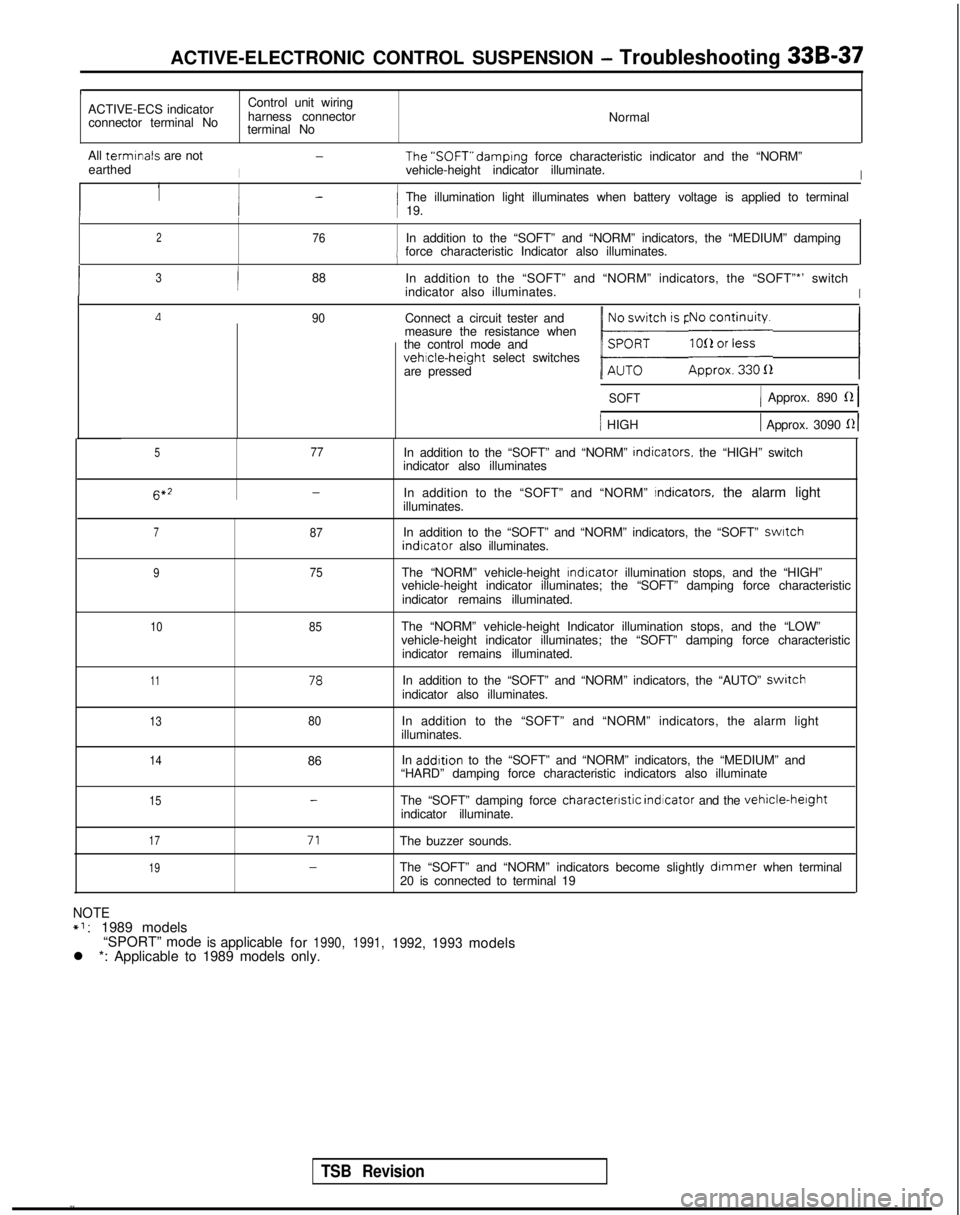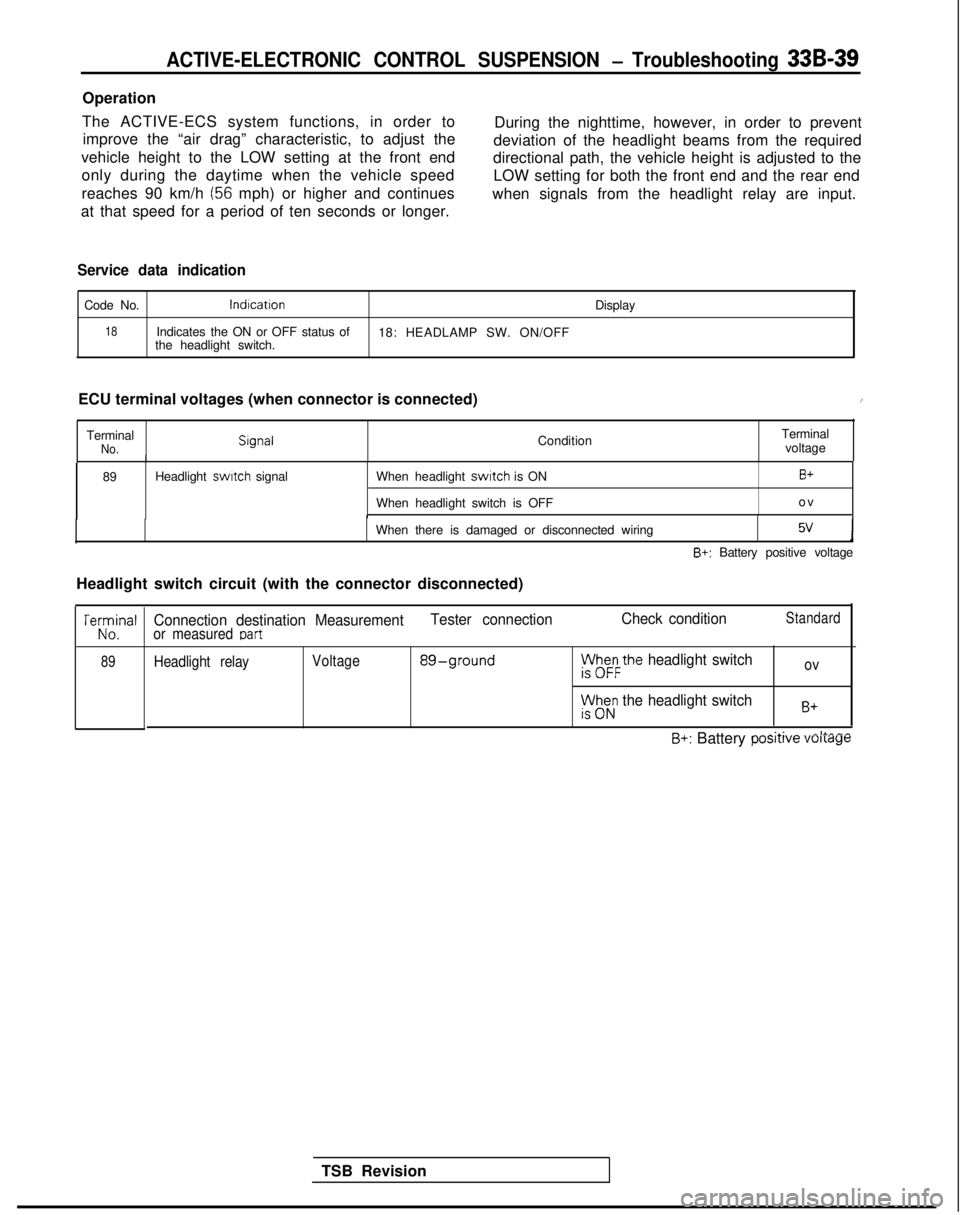1989 MITSUBISHI GALANT light
[x] Cancel search: lightPage 962 of 1273

ACTIVE-ELECTRONIC CONTROL SUSPENSION - Troubleshooting 33B-23
Operation
The G-sensor detects the amount of acceleration
that is generated (to the left or right) when the
vehi-
response to acceleration, and these changes are
cle body turns. Applying the principle of the dif-
taken out as changes of voltage. Within the coil,
ferential transformer, the magnetic field changes silicon oil is enclosed in order to suppress the vibra-
tion of the movable iron core. Note that the
G-sen-
when the movable iron core within the coil moves in
Diagnostic sor is a special sensor for control of rolling.
When signals that are otherwise virtually
in-
conceivable are input due to damaged or discon-
a heavy-line circuit, the alarm light illuminates and
control is as described in the table below.
netted wiring or a short-circuit or similar problem of
Diagnostic No.Attitude controlDamplng force
controlVehicle-heightcontrol Switch acceptanceHIGH
SPORT AUTO SOFT
I11Rolling control
only stops Normal operation
Normal operation Accept
Service data indication
Code NoIndication
Standard value Display
11G-sensor output voltage 2.5V
when vehicle is horizontal 11: G SNSR:
2.5V
ECU terminal voltages (when connector is connected)
Terminal
NoCondition
Terminal
voltageIII
34 Power supply for sensor When the ECU is activated7.3vI
28G-sensor output signal
35 Sensor circuit earth When stoppedi
When wiring is damaged or disconnected
Constantly 2.5V
ov
ov
TSB Revision
-.
Checking the G-sensor circuit (with the connector disconnected)
Terminal ConnectIon
destination or MeasurementNomeasured part Tester connection
Check conditionStandard
28 G-sensor output
Resistance
28-2ConstantlyContinuity
34G-sensor power source
Resistance34-1ConstantlyContinuity
Troubleshooting hints
Malfunction
mode Malfunction probable causeMatfunctIonNoteSilicon
oil leakage
Because the sillcon
oil for
suppresslon of
l Rolling control occurs frequently-
vlbratlons of the G-sensor movable iron core is leaktng due to a collision.
the sensitivity is
oversensitive.
Damaged or
disconnected
earth line The ground line is damaged or disconnected.
l-Malfunction is not detected because the There are times of a feeling of
ground line is grounded to the G sensor’s body incompatibility of the rolling control
l
itself, however, noise is easily picked up. Rolling
control occurs suddenly; an error
occurs
Page 964 of 1273

ACTIVE-ELECTRONIC CONTROL SUSPENSION - Troubleshooting 33B-25
OperationThe generator
‘I-” terminal signal is used to deter-
pressor
operation, and is because activation of the
mine whether or not the engine is operating.
This is in order to reduce the frequency of
com-
system is possible while the engine is operating, or
at a vehicle speed of 3 km/h (2 mph) or higher.
Diagnostic
When the generator “L” terminal is LOW level (as a result of a short-circuit of the heavy-line circuit or
due to an abnormal condition of the generator) even
though the vehicle speed is 40 km/h (25 mph),
con-
trol is as described in the table below.Note,
however, that there is no detection if there is
damaged or disconnected wiring of the harness,
and the alarm light does not illuminate.
Diagnostic No. Attitude control Damping force
control Vehrcle-height
control
HIGH
Switch acceptance
SPORTAUTOSOFT
I12‘“L” terminal “L” logic
““L” terminal “L” logic: As a result of system operation conditions, the system is not ac\
tivated at a vehicle speed of less than 3 km/h (2mph). When the vehicle speed becomes 3 km/h (2 mph) or higher all fun\
ctions are normal. (Refer to the explanation of the opera-
tron.)
Service data indication
1 CodeNo. /Indication Display
I12The output voltage level of the12: ALT. LTERMI.
HIGH/LOW
generator “L” terminal is indicated.
TSB Revision
ECU terminal voltage (when connector is connected)
Terminal
No.Signal Condition Termrnal
voltage
52Generator ‘I” terminal signal When engine stalls
When engine is operating
When harness wiring is damaged or disconnected0.5-3v
13-15v
5v
Checking the generator “L” terminal circuit (with the connector d\
isconnected)
Terminal Connection destination or
M
easurement
No.measured part Tester connectronCheck condrtion
Standard
52 Generator
Voltage52 ground Ignition switch ON
2-5V
While engine is operatingB+
B+: Battery positive voltage
Page 966 of 1273

ACTIVE-ELECTRONIC CONTROL SUSPENSION - Troubleshooting 33B-27
Operation
The low-pressure switch is switched ON and OFFby the pressure in the low-pressure tank, and as a becomes 140 kPa (20 psi) or higher, it is switched *
result the ECU functions to control the activation
OFF, and as a result the ECU sends the drive signal
and stop of the return pump. to the return pump. It is switched ON at a pressure
When the pressure in the low-pressure tank of 70
kPa (10 psi) or lower, and the return pump
stops two seconds later.
Diagnostic
If there is a short-circuit, or damaged or discon-
netted wiring, of the heavy-line
circuit,
or if the
low-pressure switch becomes shorted, and the low-pressure switch is as a result always ON, (the
trol)“, and control is as described in the table below.
alarm light illuminates during active attitude
con-
*: Information in () is applicable to 1989 models.
Not applicable to 1990 models.
Diagnostic No.Attitude control Damping force
Vehicle-height Switch acceptance
control controlHIGH
SPORTAUTOSOFT
13Control stop Normal operationNormal operation Accept
Service data indication
Code No.lndicatron
Display
13Indicates
ON or OFF condition of
13: LOW PRESS. SW. ON/OFF
the low-pressure switch
ECU terminal voltages (when connector is connected)
TSB Revision
/ Te;;,nal 1Condition Terminal
voltage
Low-pressure tank pressure
signalWhen the low-pressure switch is ONov
When the low-pressure switch is OFF5v
Checking the low-pressure switch circuit [with the connector disconnecte\
d).
I No.
Terminal Connection destination Measurement
!or measured partTester connectionCheck conditionStandard
38Low-pressure switch Resistance
38-36Low-pressure tank internalContinuit
y
pressure 70 kPa (10 psi) or
below
Low-pressure tank internalNo
pressure 140 kPa (20 psi) orcontinuity
higher.
Page 972 of 1273

ACTIVE-ELECTRONIC CONTROL SUSPENSION - Troubleshooting 33B-33
Operation
When the ignition is switched ON, the ECS power relay is also switched ON, and power is supplied to
the system. At the same time, the ECU switches
ON the solenoid
valve power relay, and power is
supplied to the solenoid valve activation circuit. As a
result, system operation is possible.
Diagnostic
When problems such as damage or disconnection of the heavy-line circuit, or fusing of the contacts of
the solenoid valve power relay, etc. occur, the alarm When the ignition switch is switched OFF after driv-
ing, the three-minute OFF delay timer makes
vehicle-height adjustment (down only) possible for a period of three minutes, thus preventing the vehicle
height from increasing while passengers get out of
the vehicle, etc.
light illuminates, and control is as described in the
table below.
Diagnostic No. 42 Attitude control
Rolling control
onlv stoos.
Damping force
Vehicle-height Switch acceptance
control control
/ HIGHSPORTAUTOSOFT
Held at MEDIUM
Rolling control
Not acceptonlv stoos
Service data indication
CodeNo /Indication Display
16Indicates ON/OFF status of the
iqnition switch. 16: IGNITION SW. ON/OFF
ECU terminal voltage (when connector is connected)
valve power relay output
26
Solenoid valve power relay drivesignalWhen solenoid valve power relay is ON
When solenoid valve power relay is OFFB+
B+: Battery positive voltage
Checking the ACTIVE-ECS power source circuit (with the connector discon\
nected)
Terminal Connection destination or Measurement ’No.measured part Tester connection
Check condition
5Ignition switchi Voltage5-groundIgnition switch OFF
Ignition switch
OFF-O
N
8Solenoid valve power
Voltage8-groundTerminal 26 open.
relay
Terminal 26 groundedStandard
o
v
O+B+
ov
O-B+
10ECU back-up power
sourcei Voltage1 O-ground
TSB Revision/ ConstantlyB+
B+: Batten/ positive voltage
Page 973 of 1273
![MITSUBISHI GALANT 1989 Service Repair Manual 33B-34 ACTIVE-ELECTRONIC CONTROL SUSPENSION - Troubleshooting
[7] ACTIVE-ECS indicators circuit
Battery
Column switch
-------
c n-21
f
ACTIVE-ECS 1indicator
I
(From 1990 models)
ECUII
F-17
Power sourc MITSUBISHI GALANT 1989 Service Repair Manual 33B-34 ACTIVE-ELECTRONIC CONTROL SUSPENSION - Troubleshooting
[7] ACTIVE-ECS indicators circuit
Battery
Column switch
-------
c n-21
f
ACTIVE-ECS 1indicator
I
(From 1990 models)
ECUII
F-17
Power sourc](/manual-img/19/57312/w960_57312-972.png)
33B-34 ACTIVE-ELECTRONIC CONTROL SUSPENSION - Troubleshooting
[7] ACTIVE-ECS indicators circuit
Battery
Column switch
-------
c n-21
f
ACTIVE-ECS 1indicator
I
(From 1990 models)
ECUII
F-17
Power source,circuif
/
EEzQ15~JgJ 1 ,2-LR
i181lllumlnatlon lightSPOK
1 1c
1’
I’
II
I 1
II
I IiI’
I I
/I
I’I 1
NOTEI-
* mark is applicable for 1991, 1992, 1993 models.ECUI TSB Revision
Page 976 of 1273

ACTIVE-ELECTRONIC CONTROL SUSPENSION - Troubleshooting 33B-37
r
ACTIVE-ECS indicator
Control unit wiring
connector terminal No harness connector
Normal
terminal No
All termrnals
are not
I
-The’SOFT” damprng
force characteristic indicator and the “NORM”
earthed vehicle-height indicator illuminate.
I
1-1 The illumination light illuminates when battery voltage is applied to t\
erminali 19.
276In addition to the “SOFT” and “NORM” indicators, the “MED\
IUM” dampingi force characteristic Indicator also illuminates.
I3/88
In addition to the “SOFT” and “NORM” indicators, the “SOF\
T”*’ switch
indicator also illuminates.
I
Ll90Connect a circuit tester and
measure the resistance when
the control mode and
vehicle-height select switches
are pressed
1 b;h is pressed.1 E;i;yi;;a 1
SOFT1 Approx. 890 fZ 1
/ HIGH1 Approx. 3090 121
577In addition to the “SOFT” and “NORM”
Indicators.
the “HIGH” switch
indicator also illuminates 6*2
-In addition to the “SOFT” and “NORM” Indicators, the alarm light
illuminates.
787In addition to the “SOFT” and “NORM” indicators, the “SOF\
T” swatch indrcator
also illuminates.
975The “NORM” vehicle-height rndicator
illumination stops, and the “HIGH”
vehicle-height indicator illuminates; the “SOFT” damping force cha\
racteristic
indicator remains illuminated.
1085The “NORM” vehicle-height Indicator illumination stops, and the “\
LOW”
vehicle-height indicator illuminates; the “SOFT” damping force cha\
racteristic indicator remains illuminated.
1178In addition to the “SOFT” and “NORM” indicators, the “AUT\
O” switchindicator also illuminates.
1380In addition to the “SOFT” and “NORM” indicators, the alarm l\
ight
illuminates.
1486 In addrtion
to the “SOFT” and “NORM” indicators, the “MEDIUM” and\
“HARD” damping force characteristic indicators also illuminate
15-The “SOFT” damping force characterrstic
indicator and the vehicle-herghtindicator illuminate.
17
1971
-
The buzzer sounds.
The “SOFT” and “NORM” indicators become slightly
dimmer when terminal
20 is connected to terminal 19
NOTE*l:1989 models
“SPORT” modeisapplicable for1990, 1991,1992,1993models
l *: Applicable to 1989 models only.
TSB Revision
Page 977 of 1273
![MITSUBISHI GALANT 1989 Service Repair Manual 33B-38 ACTIVE-ELECTRONIC CONTROL SUSPENSION - Troubleshooting
[8] HEADLIGHT SWITCH CIRCUIT
Battery1I
4Ignition
Tswitch (ACC)
c-43 l-
(From 1991 models)
(From 1990 models) A-01X
Head-
light
ECU
-L
II;
MITSUBISHI GALANT 1989 Service Repair Manual 33B-38 ACTIVE-ELECTRONIC CONTROL SUSPENSION - Troubleshooting
[8] HEADLIGHT SWITCH CIRCUIT
Battery1I
4Ignition
Tswitch (ACC)
c-43 l-
(From 1991 models)
(From 1990 models) A-01X
Head-
light
ECU
-L
II;](/manual-img/19/57312/w960_57312-976.png)
33B-38 ACTIVE-ELECTRONIC CONTROL SUSPENSION - Troubleshooting
[8] HEADLIGHT SWITCH CIRCUIT
Battery1I
4Ignition
Tswitch (ACC)
c-43 l-
(From 1991 models)
(From 1990 models) A-01X
Head-
light
ECU
-L
II;
50 >
c
;-ii -I
Kin.>r(
3
OA
/\7'6
1
I
To column switch TL
‘89F-l 6
IITo meter (upper beamindicator light)
8A
headlight
pjjimmj
C-23 (From 1990 models)
12*0642
NOTE* mark and chain line indicate 1991, 1992, 1993 models.
TSB Revision
Page 978 of 1273

ACTIVE-ELECTRONIC CONTROL SUSPENSION - Troubleshooting 33B-39
Operation
The ACTIVE-ECS system functions, in order to improve the “air drag” characteristic, to adjust the During the nighttime, however, in order to prevent
vehicle height to the LOW setting at the front end deviation of the headlight beams from the required
only during the daytime when the vehicle speed directional path, the vehicle height is adjusted to the
reaches 90 km/h
(56 mph) or higher and continues LOW setting for both the front end and the rear end
at that speed for a period of ten seconds or longer. when signals from the headlight relay are input.
Service data indication
Code No.lndlcation
Display
18Indicates the ON or OFF status of
18: HEADLAMP SW. ON/OFF
the headlight switch.
ECU terminal voltages (when connector is connected)
/
TerminalNo. Slgnal
ConditionTerminal
voltage
89 Headlight switch
signal When headlight
switch is ON
When headlight switch is OFFB+
o
v
When there is damaged or disconnected wiring
5vJ
B+: Battery positive voltage
Headlight switch circuit (with the connector disconnected)
TSB Revision
TeKJna’
89
Connection destination Measurement Tester connectionCheck conditionStandard
or measured Dart
Headlight relayVoltage 89-groundph&the headlight switchov
rt$z; the headlight switchB+
~.A.-II___B+: Battery posrrrve voltage